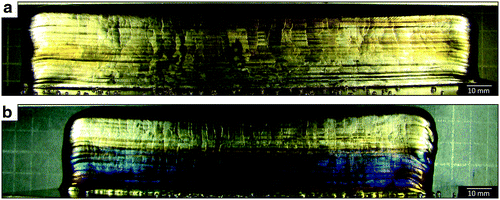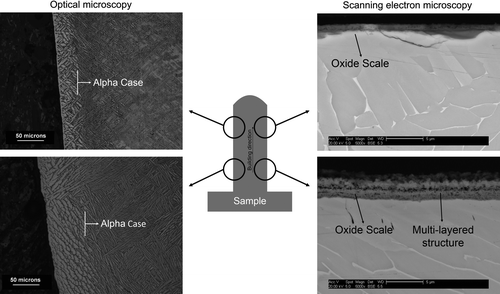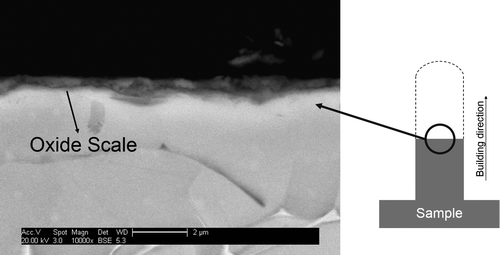Cranfield University Study Titanium Oxidation During WAAM 3D Printing
Wire and arc additive manufacturing, or WAAM, is an effective technique that has been used in the aerospace, maritime and other industries. The technology involves the use of a metal wire and an electric arc like that used in welding, and it’s faster and less expensive than other methods of additive manufacturing. However, it’s not a perfect process. In a paper entitled “Oxidation of Ti-6Al-4V During Wire and Arc Additive Manufacture,” a group of researchers discuss a common issue in WAAM – that of oxidation.
Oxidation frequently happens during WAAM due to the high reactivity of titanium with oxygen at high temperatures. A sign of oxidation is discoloration due to a brittle oxygen-enriched layer near the surface (Alpha Case), which can be detrimental to the part’s mechanical properties. The researchers investigated the oxidation of a titanium alloy during WAAM to “determine the mechanism and main process parameters controlling this phenomenon.” Plasma-transferred arc and wire deposition samples were manufactured by changing either deposition parameters or oxygen levels in the fusion atmosphere. The samples were characterized by visual inspection, optical microscope, scanning electron microscope and tensile mechanical testing.
“For any containing level of oxygen in the shielding environment, it was found that if temperatures are high enough and exposure times long, oxidation of titanium is observed,” the researchers state. “In addition, it was possible to determine that oxidation is more significant in the region of the first deposited layers. The maximum depth of Alpha Case was found to be 200 μm for the samples built with higher current (220 A) and wider oscillation width. Tensile testing revealed that increasing 40 times the oxygen levels in the shielding environment does not affect the tensile strength significantly.”
Temperature and exposure time, the researchers discovered, play more important roles than oxygen levels during the WAAM oxidation process. They conclude that as long as the shielding environment contains oxygen, oxidation occurs if temperature and exposure times are high enough, even if the oxygen levels are low.
Several overall conclusions were reached by the tests the researchers performed on the samples:
- The maximum thickness of the Alpha Case is achieved when higher current is used in combination with higher oscillation width; maximum thickness of Alpha Case found was 200 μm. High temperatures and exposure times seem to have a greater effect on oxidation than oxygen content in the shielding environment.
- For the same deposition parameters, higher oxygen levels in the shielding environment lead to a deeper Alpha Case.
- Different oxygen contents in the wire do not seem to have a significant effect on the thickness of the Alpha Case.
- Tensile properties are not compromised by an increase of oxygen in the shielding environment up to 4000 ppm. Increasing the level of oxygen significantly produces an increase in the strength and a reduction in the elongation.
Careful control of parameters can mitigate the effects of oxidation, but it remains an issue, particularly in the aerospace industry where titanium components are commonly used. Because temperatures are so high during WAAM, oxidation tends to happen and create the hard, brittle, difficult-to-machine outer layer known as Alpha Case. The authors of this paper, however, are able to offer more insight into the condition and the potential for avoiding the most serious effects.
Authors of the paper include Armando Caballero, Jialuo Ding, Yashwanth Bandari and Stewart Williams.
Discuss this and other 3D printing topics at 3DPrintBoard.com or share your thoughts below.
Subscribe to Our Email Newsletter
Stay up-to-date on all the latest news from the 3D printing industry and receive information and offers from third party vendors.
Print Services
Upload your 3D Models and get them printed quickly and efficiently.
You May Also Like
AMT Shakes Up 3D Printing Market with Affordable, High-Performance Post-Processing Consumables
Additive Manufacturing Technologies (AMT), a global leader in automated 3D printing post-processing, is launching a new line of consumables that promises to significantly reduce operational costs for additive manufacturing users....
The Bambu Lab 3D Printing Platform… or Trapdoor?
Bambu Lab began as a completely closed 3D printing system, where the printer, software, and materials all functioned well but were exclusively from the company itself. This approach mirrored Formlabs,...
2025 Renault 5 E-Tech Electric Is Latest Car with 3D Printed Accessories
Due to the required numbers, additive manufacturing (AM) has struggled to make significant inroads into vehicle interiors in meaningful numbers—at least as far as public knowledge is concerned. Typically an...
BMW Completes Project to Automate Plastic 3D Printing
After a three-year journey to efficiently scale polymer 3D printed part production, the POLYLINE project has concluded. This endeavor, headquartered at BMW’s Additive Manufacturing Campus, pooled the expertise of EOS,...

































